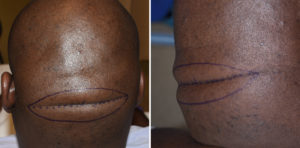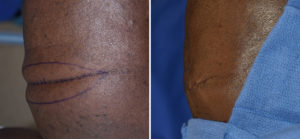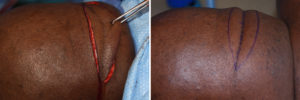Background: The scalp is a remarkably thick and well vascularized tissue as it covers the entire skull surface. Its thickness, however, varies at different areas of the skull. It is the thickest on the back of the head where it blends into the posterior neck tissues. The base of the occipital skull also ends up much higher than one thinks, leading to a thick collection of tissue over the back of the head without any underlying bone support.
Scalp rolls on the back of the head appear to occur due for a variety of reasons. Naturally thick scalp and neck tissues, excessive scalp laxity, short necks and being overweight can all contribute to a bunching up of scalp soft tissues in this area. Scalp rolls can appear as a single, double and even a triple roll. The most common presentation is a double roll with deep horizontal skin crease between them.
Skin rolls on the back of the head is an almost exclusive male aesthetic concern. Shaved heads and very closely cropped hair make them visible and can be a source of embarrassment.



Highlights:
1) Occipital scalp rolls can have multiple presentations from one to three rolls on the back of the head.
2) Excision of a wedge of skin and deeper tissues allows for scalp roll reduction.
3) Widely undermining the scalp flaps above and below the excised tissues helps to work out adjoining rolls as well.
Dr. Barry Eppley
Indianapolis, Indiana



